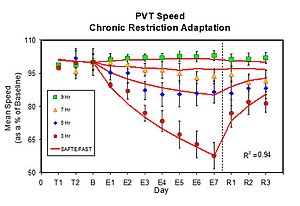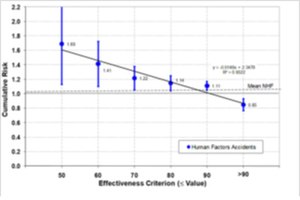SAFTE-FAST
Script error: No such module "Draft topics".
Script error: No such module "AfC topic".
SAFTE-FAST is Fatigue Risk Management System software provided by the Institutes for Behavior Resources, Inc (IBR). SAFTE stands for Sleep Activity Fatigue Task Effectiveness. The SAFTE model is a biomathematical model of fatigue—a computerized model that predicts alertness, performance, circadian phase, or fatigue as a function of sleep, work, and time-of-day. The SAFTE model was invented by Dr. Steve Hursh. FAST stands for Fatigue Avoidance Scheduling Tool. Biomathematical models of fatigue, like SAFTE-FAST, are used by industries, mainly aviation and rail transportation, to predict fatigue that can be expected from sleep and work schedule data.
History[edit]
Model Development by US Military[edit]

The SAFTE model, patented in 2003, was developed primarily for use by the US Department of Defense (DoD) and based on extensive research at the Walter Reed Army Institute of Research (WRAIR)[1][2][3][4][5]. The SAFTE model was invented by Dr. Steve Hursh. The model was developed and tested based on the results of a chronic sleep restriction study conducted at WRAIR that compared actual performance on the psychomotor vigilance task (PVT) against SAFTE-FAST prediction during periods of sleep deprivation and recovery[2][1]. SAFTE-FAST was also tested against objective performance outcomes (PVT) in the field[6][7]. The FAA sponsored a study with aircrew to reinforce the validity of the SAFTE model within the exceptionally dynamic operational environment of commercial aviation.
The SAFTE model was updated in 2004 with an expression that adapts the model to the prolonged effects of sleep restriction and optimizes it for prediction of the most sensitive performance test, the Psychomotor Vigilance Task.[8][2] 7,13. This feature of the SAFTE model is key to accurate applications in the civilian world, where chronic sleep restriction, not total sleep deprivation, is the dominant sleep pattern that threatens performance in the workplace. Findings of a 2004 independent peer review published by the University of Pennsylvania judged SAFTE to have the lowest estimation error of any fatigue model[1][6]
Software Development for Commercial Applications[edit]
Inventor Dr. Steven Hursh received funding for commercial applications. Because civilian employers do not collect data on employee sleep, it was necessary to develop a way to estimate sleep directly from the work record. An algorithm predicting the sleep habits of railroad engineers[9] was developed using sleep and work diary data collected from railroad engineers[10]. The sleep prediction algorithm (Auto-Sleep) invented by Dr. Hursh accurately predicts the average pattern of sleep associated with any work schedule in order to provide an assessment of fatigue. Auto-Sleep has been validated against wrist activity records (actigraphy) and sleep logs in aviation and rail workers[6][8][9][11]. The algorithm can be trained to predict sleep patterns in working populations with specific sleep patterns using previously-collected actigraphy data in a process called harmonization. The harmonized Auto-Sleep settings can then be used for prospective modeling of proposed new schedules. Harmonization studies have been done for aviation and firefighter schedules[12][13]. SAFTE-FAST with Auto-Sleep has become a useful tool for the assessment of fatigue associated with civilian work schedules.
Accident Validation[edit]

SAFTE-FAST was evaluated against work schedules preceding 1,400 freight railroad accidents over 2½ years. Each accident was associated with two employees in the locomotive. 30-day work histories of 2,800 employees involved in these accidents were processed through a SAFTE-FAST special batch processor version developed by Dr. Timothy Elsmore. Of the 1,400 accidents, 400 were attributed to an error by the crew. For those accidents, the SAFTE model was able to predict a highly significant relationship between decreased performance and elevated accident risk. At the most extreme levels of predicted performance degradation (fatigue), the model accurately predicted a 65 percent elevation in risk. As expected, no such relationship existed for the 1,000 accidents attributed to nonhuman causes[7]. The SAFTE model predicts a 430 percent elevation in economic risk when fatigued, and a 400 percent increase in average accident cost, relative to well-rested workers. Being fully rested was protective, reducing economic risk 75 percent and average accident cost 54 percent relative to the average accident[14]
References[edit]
- ↑ 1.0 1.1 1.2 Hursh SR, Redmond, D.P., Johnson, M.L., Thorne, D.R., Belenky, G., Balkin, T.J., Miller, J.C., Eddy, D.R., and Storm, W.F. . The DOD sleep, activity, fatigue, and task effectiveness model. In. Scottsdale, AZ, USA: In Proceedings of the 12th Conference on Behavior Representation in Modeling and Simulation; 2003.
- ↑ 2.0 2.1 2.2 Hursh SR, Balkin, T.J., Miller, J.C., and Eddy, D.R. The fatigue avoidance scheduling tool: Modeling to minimize the effects of fatigue on cognitive performance. SAE Transactions 113 (1), 111–119.
- ↑ Balkin TJ, Thorne, D., Sing, H., Thomas, M., Redmond, D., Wesensten, N.J., Williams, J., Hall, S., and Belenky, G. Effects of sleep schedules on commercial driver performance (Report No. DOT–MC–00–133). Washington, DC: U.S. Department of Transportation, Federal Motor Carrier Safety Administration2000.
- ↑ Belenky G, Wesensten NJ, Thorne DR, et al. Patterns of performance degradation and restoration during sleep restriction and subsequent recovery: a sleep dose-response study. J Sleep Res. 2003; 12 (1): 1-12.
- ↑ Hursh SR, Redmond DP, Johnson ML, et al. Fatigue models for applied research in warfighting. Aviation, space, and environmental medicine. 2004; 75 (3): A44-A53.
- ↑ 6.0 6.1 6.2 Hursh SR, Raslear, T.G., Kaye, A.S., and Fanzone, J.F. Validation and calibration of a fatigue assessment tool for railroad work schedules, summary report. (Report No. DOT/ FRA/ORD–06/21). Washington, DC, USA: Federal Railroad Administration;2006.
- ↑ 7.0 7.1 Roma PG, Hursh SR, Mead AM, Nesthus TE. Flight attendant work/rest patterns, alertness, and performance assessment: Field validation of biomathematical fatigue modeling. Federal Aviation Administration Oklahoma City Ok Civil Aerospace Medical Inst;2012.
- ↑ 8.0 8.1 Van Dongen H. Comparison of mathematical model predictions to experimental data of fatigue and performance. Aviation, space, and environmental medicine. 2004; 75 (3): A15-A36.
- ↑ 9.0 9.1 Gertler J, Hursh S, Fanzone J, Raslear T, America QN. Validation of FAST model sleep estimates with actigraph measured sleep in locomotive engineers. United States. Federal Railroad Administration;2012.
- ↑ Pollard J. Locomotive Engineer’s Activity Diary (Report No. DOT/ FRA/RRP-96/02). Washington, DC, USA: Federal Railroad Administration;1996.
- ↑ Devine JK, Garcia CR, Simoes AS, et al. Predictive Biomathematical Modeling Compared to Objective Sleep During COVID-19 Humanitarian Flights. Aerosp Med Hum Perform. 2022; 93 (1): 4-12.
- ↑ Devine JK, Nichols M, Schwartz LP, Choynowski J, Hursh SR. 0136 Firefighter Sleep Behavior and Psychomotor Vigilance Compared to Biomathematical Predictions of Performance. Sleep. 2022; (Supplement).
- ↑ Paul MA, Hursh SR, Love RJ. The Importance of Validating Sleep Behavior Models for Fatigue Management Software in Military Aviation. Mil Med. 2020; 185 (11-12): e1986-e1991.
- ↑ Hursh SR, Fanzone, J.F., and Raslear, T.G. Analysis of the Relationship between Operator Effectiveness Measures and Economic Impacts of Rail Accidents (Technical Report DOT/FRA/ORD-11/13). Washington, DC, USA: U.S. Department of Transportation;2011.
This article "SAFTE-FAST" is from Wikipedia. The list of its authors can be seen in its historical and/or the page Edithistory:SAFTE-FAST. Articles copied from Draft Namespace on Wikipedia could be seen on the Draft Namespace of Wikipedia and not main one.
